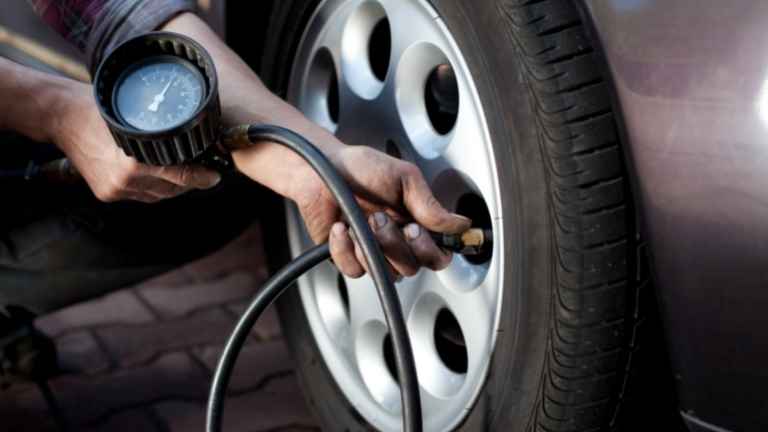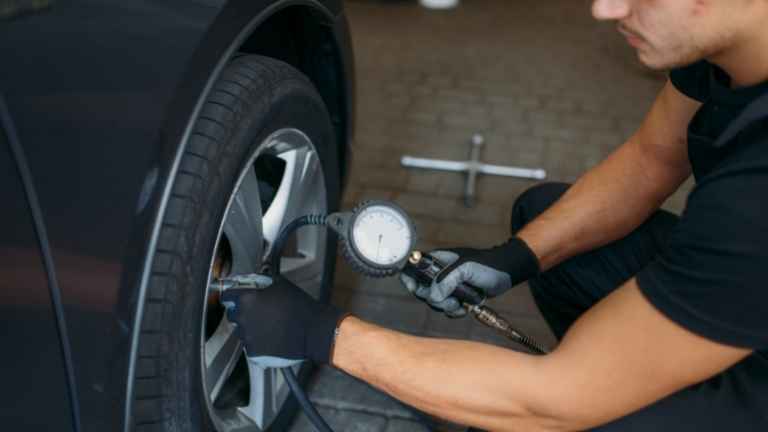The tire is an important part of the car. It provides traction to the vehicle, and so it’s crucial that it has enough air.

A good rule of thumb is to check your tire pressure once a month or before every long trip. You can find out how much pressure you need by looking at the manual for your car or truck, but in general, most cars require between 30-35 psi per tire when driving on flat ground.
If you notice that your tires are low on air then be sure to get them filled up as soon as possible because even one PSI will make a difference in handling and fuel efficiency. So, if you want to keep yourself safe and save some money, be sure not to forget about your tires.
How Often Should I Check Tire Pressure?
It depends on what is typical for your car or truck. You should check the pressure in all of them-even the ones that are not yet low- once a month, or before a long trip to prevent accidents.
The best way to check if your tire pressure is okay and at what PSI they should be set at is by looking at your manual or asking around for tips on what others having the same model have done.
However, some general guidelines would state that it’s important to check both front and back tires every time gas is added – as air will leak out of it – check more often when:
- Underinflated
- Driving in hilly areas
- Weather conditions changes
- Driving on dirt or rocky roads
If so, check and add air. There are also car apps that you can use to see if your pressure is where it needs to be. Some will remind you to check the pressure regularly. So, you’re not required to remember when you checked the pressure last time.
Another thing you should keep in mind is that even though the average person runs on 33psi tires when driving on flat ground, some cars will require a different amount of PSI depending on their weight and size – so always make sure to check your manual first! And never underinflate or overinflate the tires as it can affect handling and put other people’s lives in danger as well!
Is there any difference in tire pressure for winter and summer?
It is important to keep the tire pressure at a good level year-round as it determines how much fuel you will use and how safe you are on the road.
However, most people do raise the air pressure for winter because of snow and ice conditions. But if your tires are already inflated then do not overinflate them by keeping in mind that excessive inflation can affect handling.
It is always better to check the owner’s manual for perfection. But for you to know the basic, here are two facts-
- As the temperature goes down, tire pressure reduces as well. So, winter season requires additional tire pressure than normal.
- For every 10 degree Fahrenheit rise in temperature, tire pressure will automatically rise by 1 PSI. So, summer days require less air pressure than winter.
Since the pressure varies depending on the vehicle and tire, you should check the car owner’s manual to be in the safe side.
What causes low tire pressure?
The number one reason for this problem is leakage-when there’s a hole in the side of the tire or wheel through which air escapes from inside of it.
Leaks might be caused by:
- Continuous driving with underfilled tires
- Inaccurate filling
- Incorrect valve stem/valve core
- Maintenance issues
How to Fix Low Tire Pressure?
Make sure the tire is properly inflated with a pressure gauge. Inflate the tire until it reaches its recommended level.
Make sure to check that you haven’t installed an incorrect valve stem or valve core. Replace them if they are not correct for your vehicle’s wheels.
Make sure there aren’t any leaks before reinstalling the wheel on the axle. Tighten fasteners and make sure everything is in place correctly without air leaking out from anywhere.
One of the biggest complaints about cars today is poor gas mileage – everyone wants more miles per gallon! If you’re having trouble seeing improvements in your MPG, then be sure to read this article about what affects fuel economy and get tips on how to improve your fuel economy and how to troubleshoot issues with it.
Read: 10 Best Cordless Impact Wrench For Changing Tires
Why do I have to put air in my tire every week?
Air leaks from tires all the time. It occurs even when they are not used. A slow leak will be too small to detect but it can still boil and cause a blowout.
If you need to put air in the tire every week, there is something wrong with your tires. It is a good idea to check how much pressure you lose in a week to determine the gravity of the issue.
Start by checking if there is any leak in the tire. Check if the valve stem is improperly installed or leaking air. Sometimes we don’t find anything yet we lose air pressure fast. In that case, it is best to consult professionals for safety.

What to Know About Checking and Filling Your Tire Pressure?
Because the tire is flexible, you should not rely on it as a standard ruler. You need to measure the circumference of your tires to learn about their pressure levels.
Expert mechanics recommend finding out how much pressure is needed for every axle before taking your vehicle on a trip.
How To Check Your Tire Pressure?
The best way to find out the correct tire pressure is to check it yourself with a portable air pressure gauge. It is perfectly fine if you use an analog, dial style gauge instead of digital, because they both give accurate readings. The process of checking your tire inflation should be part of every car owner’s auto maintenance work schedule. You can do this yourself in just 5 minutes:
Turn off the engine and take out the car key.
The tires should cool down for about an hour before taking pressure measurements, otherwise, your results would not be accurate.
To start off, find the valve stem by looking for the small hole near the wheel rim or locating it with a flashlight and a mirror if you still can not see it at night time.
Attach the pressure gauge to the valve stem firmly and make sure there is no ‘hiss’ sound.
It is very important that you hold the gauge upright when reading it because atmospheric pressure has a vertical component and if there are any leaks in your tire they will cause inaccurate readings too.
Start from the front right side wheel and work around until all four wheels have been checked. If the tires do not match each other within 2 pounds, then readjust them accordingly unless the manufacturer has something unique for you in the owner’s manual.
What Should I Do To Be Safe on the Road?
Though the tire is an important part of your car, it’s still quite possible to have a flat tire or have problems with them even if you take excellent care of them. Still, how are you going to change that flat in the middle of nowhere? How can you get back on the road when there is no one around to help?
The good thing is that you can always rely on a portable tire inflator. Whether your car has an inflatable spare or not, a tire inflator is your best friend if you want to remain safe and continue your journey. It’s easy to take with you in the trunk of your car, and it takes only a few minutes to use it.
Final Words
The best way to find out the correct tire pressure is by checking it yourself with a portable air-powered pump. After you’ve verified that your tires are inflated, make sure you check them again at least once every month!
It’s imperative that car owners have their own portable pumps and use them on a regular basis in order to avoid having an accident due to low tire pressure or even worse, be stranded because of flat tires. If all of this sounds intimidating and you want help enacting these principles, let us know.
